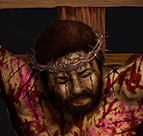The Image of a Suffering Servant
The crucifixion of Jesus has been a very popular subject in classical art, with the earliest depictions starting from 4th century CE. The image of Jesus, caucasian with long wavy light-brown hair, on a cross made of two wooden beams, with nails piercing the wrists and feet, has been largely unchanged all throughout the centuries.
Biblical anthropologists and scientists, however, have long held the idea that this common image is far from an accurate depiction of how Jesus, and the crucifixion, may have looked.
With this in mind, I worked towards conceptualizing an updated image of the crucifixion, taking the latest findings as reference for the painting.
Joseph Zias, Curator of Archaeology and Anthropology for the Israel Antiquities Authority from 1972 to 1997, and Dr. Eliezer Sekeles, of the Hadassah Medical Center, have published their findings on the skeletal remains of a crucified man from Giv’at ha-Mivtar, a Jewish neighborhood in northern East Jerusalem. They proposed that permanent vertical stakes were used in the crucifixion, each affixed with a horizontal beam, with the executed’s arms tied.
Richard Neave, retired medical artist from the University of Manchester, England, recreated his version of Jesus’ face from features that are typical of Galilean Semites that lived in Jesus’ time.
The inscription above Jesus’ head, the Titulus Crucis, was hypothetically reconstructed by P.I. Meier according to first-century Latin, Greek, and Semitic formal inscriptions.
These were the basis for this new painting of Jesus, titled the Suffering Servant. It’s inspired by Diego Velasquez’ 1632 painting, Christ Crucified.
